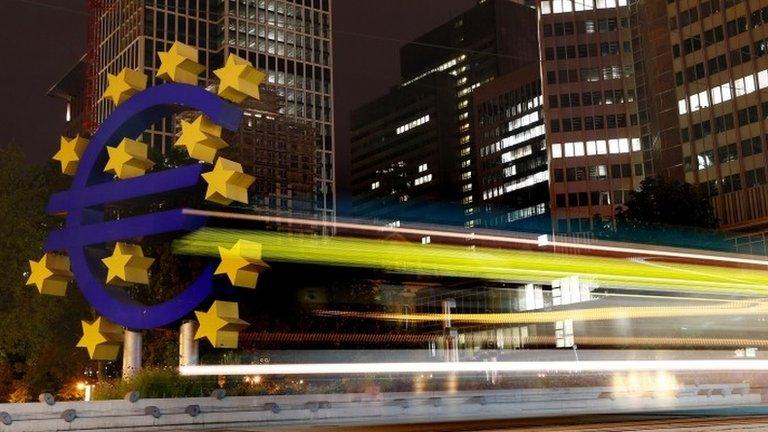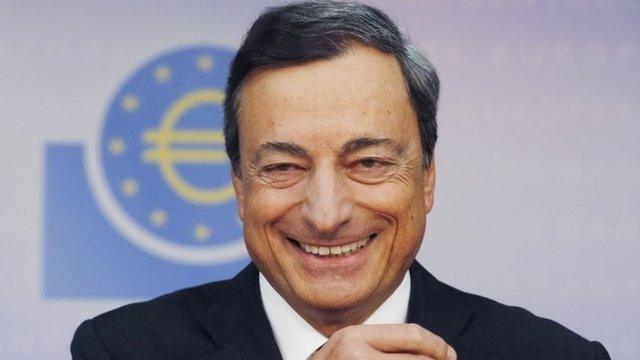Draghi comments send euro to lowest level since 2010
- Published

The value of the euro has fallen to its lowest level since the middle of 2010, following comments from Mario Draghi, the president of the European Central Bank (ECB).
In a newspaper interview, he hinted again that the bank might soon start a policy of quantitative easing to try to stimulate the eurozone economies.
The aim would be to stop the continued fall in the general level of prices.
The euro fell 0.4% to $1.2034 after Mr Draghi's comments were made public.
Recently, the official eurozone inflation rate has fallen to just 0.3%.
'Making preparations'
To stop deflation - falling prices - gaining a grip on the world's largest trading bloc, the ECB could launch its own programme of quantitative easing (QE) by buying government bonds, thus copying its counterparts in the UK and the US.
The purpose would be to inject cash into the banking system, stimulate the economy and push prices higher.
Speaking in an interview with the German newspaper Handelsblatt, Mr Draghi said: "We are making technical preparations to alter the size, pace and composition of our measures in early 2015."
Lee Hardman, a currency analyst at Bank of Tokyo-Mitsubishi UFJ, said: "The comments suggest the ECB will soon adopt sovereign debt QE, which may come as soon as their next meeting.''
If bond prices rose because of this extra demand from the central bank, the yield available to bond investors would fall, with the knock-on effect of reducing the general level of interest rates in the eurozone banking system.
And it is that prospect which has helped to weaken the value of the euro on the foreign exchanges.
Many hints
Although the ECB has already cut interest rates to a record low level, and also bought some bonds issued by private companies, a full-scale programme of QE has not yet been launched.
But it has been on the cards since April 2014, when Mr Draghi made the first of a series of comments suggesting that he might trigger such a policy in due course.
"It [the euro] could break below $1.20 since there is a risk of a very low inflation reading out of the euro zone next week," said Niels Christensen, an FX strategist at Nordea.
"That will just add to pressure on the ECB to take measures when it meets later this month."
The next ECB policy meeting will be on 22 January.
Eurozone concerns
Consumer inflation has not been at the ECB's target level of just below 2% since the start of 2013, and has been falling since a 3% peak late in 2011.
The eurozone's low inflation has been blamed for undermining growth, and has already prompted ECB stimulus measures.
In September, the bank said it would begin buying covered bonds, which are bonds backed by public sector loans or mortgages.
In December Mr Draghi said ECB staff "have stepped up the technical preparations for further measures, which could, if needed, be implemented in a timely manner."
Traders have a number of eurozone concerns going into 2015, including the outcome of a snap election in Greece on 25 January.
The left-wing Syriza coalition is ahead in opinion polls and rejects EU austerity measures, which have been blamed for soaring unemployment and a rise in poverty in the country.
There are doubts about Greece's future in the eurozone should it fail to stick with its agreed austerity programme.

Analysis: Andrew Walker, economics correspondent, BBC World Service
Mr Draghi's remarks are yet another signal that full-scale quantitative easing in the eurozone is probably coming. It could be less than three weeks away.
The ECB's first major policy meeting of the year is on 22 January. Another clue to the ECB's likely actions comes next week, when we get a first estimate for eurozone inflation in December.
The previous month's figure was 0.3%. Anything lower would reinforce the odds of early action by the ECB.
And there are plenty of reasons to think inflation might be lower.
There is the continued decline in global oil prices, and new business survey data suggesting the eurozone is still weak.
We have also had figures for Spain in December showing prices falling more rapidly than before.

- Published6 November 2014

- Published2 October 2013

- Published4 September 2014

- Published8 May 2014
